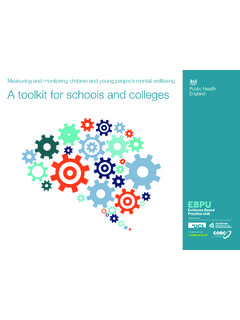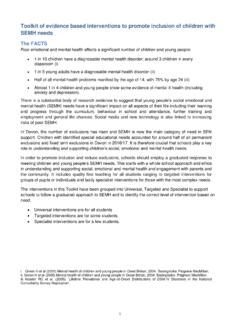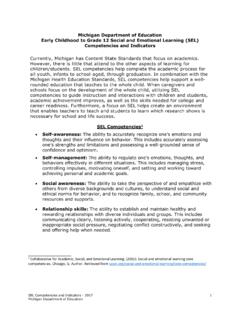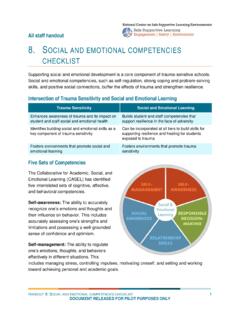Transcription of SECONDARY SOCIAL AND EMOTIONAL ASPECTS OF …
1 Research Report DFE-RR049 SOCIAL and EMOTIONAL ASPECTS of learning (SEAL) programme in SECONDARY schools: national evaluation Neil Humphrey Ann Lendrum Michael Wigelsworth This research report was commissioned before the new UK Government took office on 11 May 2010. As a result the content may not reflect current Government policy and may make reference to the Department for Children, Schools and Families (DCSF) which has now been replaced by the Department for Education (DFE). The views expressed in this report are the authors and do not necessarily reflect those of the Department for Education EXECUTIVE SUMMARY SEAL is a comprehensive, whole- school approach to promoting the SOCIAL and EMOTIONAL skills that underpin effective learning, positive behaviour, regular attendance, staff effectiveness and the EMOTIONAL health and well-being of all who learn and work in schools (DCSF, 2007, ).
2 National Strategies report that it is currently being implemented in around 90% of primary schools and 70% of SECONDARY schools. The aims of this national evaluation of SECONDARY SEAL were to (a) assess the impact of SECONDARY SEAL on a variety of outcomes for pupils, staff and schools, and (b) examine how schools implemented SEAL, with particular reference to the adoption of a whole- school approach. Research Design Our research combined quantitative and qualitative inquiry. The former was utilised mainly to provide data pertaining to the impact of SECONDARY SEAL, and the latter was used primarily to provide insights into the implementation process.
3 For the quantitative component, 22 SEAL schools and a matched group of 19 comparison schools were recruited to take part in a quasi-experimental study. Pupils in Year 7 at the beginning of the academic year 2007/8 (N = 8, 630) were the target cohort. Key outcome data ( pupils SOCIAL and EMOTIONAL skills, mental health difficulties, pro- SOCIAL behaviour and behaviour problems) was collected from the target cohort via self-report surveys on an annual basis: at the beginning of 2008 (Time 1 baseline), at the beginning of 2009 (Time 2 interim. NB: this wave of quantitative data collection was only used to inform our unpublished interim reporting) and finally at the beginning of 2010 (Time 3 post-test).
4 For the qualitative component, nine of the 22 SEAL schools from the quantitative impact strand were recruited to participate in longitudinal qualitative case studies. These case study schools were visited five times (roughly once per term) during the course of our fieldwork. Data collection in the case study schools comprised of observations of lessons and other contexts, interviews and/or focus groups with members of the school community ( pupils, teachers, SEAL leads, head teachers, and LA staff) and analysis of school documents ( SEAL self-evaluation forms, policy documents). After fieldwork had begun, the then DCSF requested that additional quantitative data be collected pertaining to pupil and staff perceptions of school climate, staff SOCIAL and EMOTIONAL skills, and pupil understanding, knowledge and involvement in SEAL.
5 These additional quantitative measures were implemented in our nine longitudinal case study schools following the same timetable as described above for the quantitative impact strand. 1 Findings In terms of implementation, our analysis of case study schools approaches to, and progress in SEAL implementation revealed a very mixed picture. Schools such as CS5, CS6 and CS3 made comparatively good progress in implementation, and were able to provide clear evidence of engagement in the suggested school improvement cycle. However, schools like CS2, CS4 and CS10 made comparatively little progress over the same period of time.
6 Our subjective impressions of these schools and analysis of other relevant data suggest that a whole range of issues were influential in determining these differences including a somewhat superficial approach to implementation ( box ticking ) and a failure to sustain initial activity levels in the latter schools. However, our analysis of impact data for each school revealed that this made little difference to outcomes for pupils, with very little variation evident between schools. Our nine case study schools were extremely variable and fragmented in the extent to which they adopted a whole- school approach to implementing SEAL. An issue here may be the necessarily limited time frame within which this evaluation study was conducted.
7 Development of a truly whole- school nature inevitably takes time to become fully embedded. This may be particularly true of large, complex institutions such as SECONDARY schools. The patchy approach seen in most schools may simply be a reflection of this truism. However, there are also other issues which may have contributed to the lack of a consistent whole- school approach. Firstly, some schools interpreted the SEAL guidance in such a way that they purposively selected pockets of activity or development to focus upon, at the expense of the bigger picture . This was often in tandem to a perception that SEAL did not offer them something new. Sustaining the effort and energy required to drive SEAL forward at various levels was also a problem for some, especially in the face of competing pressures.
8 Alongside this, a perception that things would begin to change in the short-term among some staff lead to a withdrawal of effort and interest when this did not happen. Consistent with the findings of previous research ( Greenberg et al, 2005; Durlak and DuPre, 2008), our analysis of qualitative case study school data revealed a range of barriers and facilitators relating to preplanning and foundations, implementation support systems, implementation environment, implementer factors, and programme characteristics. The factors identified clearly interacted in creating the conditions for effective (or ineffective) implementation of SEAL. Amongst these factors, we tentatively point to staff will and skill , in addition to time and resource allocation, as being the most crucial in driving implementation forward (or, indeed, holding it back).
9 Finally, in terms of impact, our analysis of pupil-level outcome data indicated that SEAL (as implemented by schools in our sample) failed to impact significantly upon pupils SOCIAL and EMOTIONAL skills, general mental health difficulties, pro- SOCIAL behaviour or behaviour problems. The school -level variable of SEAL status ( whether a given school were implementing SEAL or not) was close to statistical significance in the analyses of SOCIAL and 2 EMOTIONAL skills and general mental health difficulties (indicating the possibility of a SEAL effect ). However, the effect sizes associated with this variable were marginal for instance, being at a SEAL school was associated with just a reduction in SDQ total difficulties score at Time 3.
10 In relation to school -level outcome data, our analyses indicated that SEAL (as implemented by schools in our sample) failed to have a positive impact, although the results were less straightforward here. Analysis of school climate scores indicated significant reductions in pupils trust and respect for teachers, liking for school , and feelings of classroom and school supportiveness during SEAL implementation. Additionally, qualitative data around perceptions of impact indicated a feeling that SEAL had not produced the expected changes across schools. However, school climate data also showed a significant increase in pupils feelings of autonomy and influence, and this was supplemented by anecdotal examples of positive changes in general outcomes ( reductions in exclusion), as well as more specific improvements in behaviour, interpersonal skills and relationships.


















